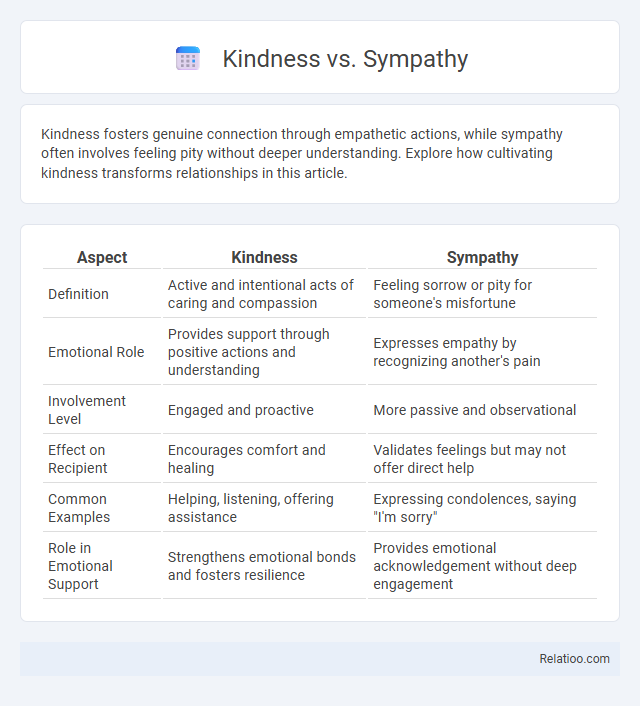Kindness fosters genuine connection through empathetic actions, while sympathy often involves feeling pity without deeper understanding. Explore how cultivating kindness transforms relationships in this article.
Table of Comparison
| Aspect | Kindness | Sympathy |
|---|---|---|
| Definition | Active and intentional acts of caring and compassion | Feeling sorrow or pity for someone's misfortune |
| Emotional Role | Provides support through positive actions and understanding | Expresses empathy by recognizing another's pain |
| Involvement Level | Engaged and proactive | More passive and observational |
| Effect on Recipient | Encourages comfort and healing | Validates feelings but may not offer direct help |
| Common Examples | Helping, listening, offering assistance | Expressing condolences, saying "I'm sorry" |
| Role in Emotional Support | Strengthens emotional bonds and fosters resilience | Provides emotional acknowledgement without deep engagement |
Understanding Kindness and Sympathy
Understanding kindness involves recognizing genuine acts of goodwill that are motivated by empathy and a desire to improve someone's well-being, while sympathy refers to feeling pity or sorrow for someone else's misfortune without necessarily taking action. Kindness goes beyond sympathy by prompting you to offer support or help, transforming emotional understanding into positive behavior. Distinguishing these concepts enhances your emotional intelligence and fosters deeper, more meaningful connections.
Defining Kindness: Core Attributes
Kindness encompasses genuine actions motivated by empathy, compassion, and the desire to improve others' well-being, distinguishing it from sympathy and pity. Core attributes of kindness involve active generosity, understanding, and selflessness, which foster meaningful connections and positive emotional impact. Unlike sympathy, which often implies feeling concern without direct action, kindness requires intentional behavior that benefits others.
Sympathy Explained: Key Characteristics
Sympathy involves feeling concern or sorrow for someone else's misfortune while maintaining emotional distance, which distinguishes it from kindness that is characterized by active goodwill and helpful actions. Unlike empathy, which requires personally understanding another's emotions by putting yourself in their place, sympathy expresses acknowledgment of others' pain without shared emotional experience. Understanding these key characteristics helps you respond appropriately to others' struggles by offering comfort without overstepping personal boundaries.
The Emotional Differences Between Kindness and Sympathy
Kindness involves genuine, proactive concern for others' well-being expressed through actions that foster connection and support. Sympathy centers on recognizing and feeling sorrow for another's distress without necessarily taking action, often maintaining emotional distance. The emotional difference lies in kindness's active empathy and engagement, while sympathy remains a passive acknowledgment of suffering.
Motivations Behind Kindness vs Sympathy
Kindness stems from a genuine desire to improve others' well-being without expecting anything in return, reflecting intrinsic motivation and empathy-driven behavior. Sympathy involves recognizing and feeling sorrow for others' suffering but often lacks the proactive element of helping, driven more by emotional resonance than actionable intent. Understanding these motivational differences highlights how kindness actively seeks to alleviate distress, while sympathy primarily acknowledges it.
Psychological Impacts on Recipients
Kindness fosters positive psychological impacts on recipients by promoting feelings of worth, connection, and emotional well-being, which can reduce stress and boost self-esteem. Sympathy, while well-intentioned, may inadvertently highlight a recipient's vulnerabilities or create feelings of pity, potentially leading to discomfort or dependence. By emphasizing genuine kindness, Your support encourages empowerment and resilience, enhancing mental health more effectively than mere expressions of sympathy or pity.
Real-Life Examples: Kindness in Action vs Sympathy in Action
Kindness in action manifests through tangible deeds such as volunteering at homeless shelters or helping a neighbor carry groceries, demonstrating proactive compassion and support. Sympathy in action often involves expressing heartfelt concern or offering emotional comfort, like sending a condolence card or listening attentively during difficult times. Real-life examples distinguish kindness by active help and tangible support, while sympathy centers on emotional connection and understanding without necessarily changing the situation.
Effects on Relationships: Building Bonds or Creating Distance
Kindness fosters genuine connections by promoting trust and empathy, which strengthens relationships and encourages mutual support. Sympathy can create emotional distance if it leads to pity rather than understanding, potentially making individuals feel isolated or misunderstood. While compassion combines the awareness of others' suffering with a desire to help, it actively builds bonds by encouraging proactive support and emotional closeness.
Cultivating Kindness Over Mere Sympathy
Cultivating kindness involves active empathy and genuine concern for others' well-being, whereas sympathy often remains a passive acknowledgment of someone's pain. Your efforts to nurture kindness encourage meaningful connections and proactive support, moving beyond superficial feelings. Prioritizing kindness fosters lasting positive impact, promoting emotional resilience and trust.
Choosing Kindness in Everyday Life
Choosing kindness in everyday life fosters genuine connections and promotes emotional well-being, contrasting with sympathy, which often implies a distant acknowledgment of others' struggles. While sympathy recognizes pain, kindness involves compassionate actions that actively support and uplift those around you. Your consistent choice to practice kindness creates a positive ripple effect that enhances both your life and the lives of others.

Infographic: Kindness vs Sympathy
 relatioo.com
relatioo.com